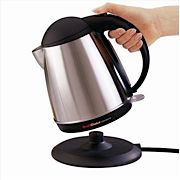Ready to save some more money on your bills? Great. You’ve come to the right place.
This week I’ll be taking a look a 5 simple ways to use your kettle more efficiently.
If you drink as much tea as I do, that’s definitely a good thing.
Why pick on the lowly kettle?
 The kettle is an extremely common appliance – in many countries, almost everyone will have at least one. It’s also used on a regular basis; often several times per day.
The kettle is an extremely common appliance – in many countries, almost everyone will have at least one. It’s also used on a regular basis; often several times per day.
In terms of energy efficiency, however, it isn’t exactly the best around. A typical kettle draws an astonishing 3kW of power. To give you an idea of just how much this is, here’s a look at how other common appliances stack up :
- computer – 100 W
- vacuum – 200 W
- blender – 300 W
- dishwasher – 1,200 W
- kettle – 3,000 W
As you can see, the kettle deserves a little attention.
How can you get that 3,000 watts down a bit?
Unlike most appliances, there isn’t much to be gained by simply going out and buying a new one. Current models aren’t much more efficient than those of several decades ago.
There are, however, a number of minor changes you can make that will really pay off when the bills come in. A few suggestions :
-
Only boil as much water as you need
If you’re only making a cup of tea for yourself, there’s no need to fill it up. It’ll just take longer to boil, and use a lot more power in the process.
If your kettle already has a see-through window with markings on it, great. If not, just fill the cup you’re about to use (with water) and tip it into the kettle to gauge the right amount.
-
Keep the water hot, longer
The warmer a kettle’s water is to start with, the less effort is taken to boil it the next time. Whenever possible, leave the kettle in a warm spot.
You can even – and I never thought I’d say this – use a tea cosy. Just not one of the excessively frilly ones, please.
The starting temperature of the water can also make a big difference. Fill the kettle from the hot tap (most water heaters are reasonably efficient), or – even better – with water that’s already been heated for cooking. I’m not talking about the contents of your saucepan here, but if you’ve been doing a little steaming, use that. The water’s fine.
-
Switch it off before it reaches boiling point
Different hot drinks enjoy water heated varying amounts, but none of them requires the water to be boiling. Why do kettles boil the water then? It’s easier.
If you’re making a cup of tea (black, green or white), the ideal temperature is around 71C – 76C. For those of you who don’t happen to have a kitchen thermometer around, this is roughly when the water starts to move around in the kettle (you can hear it, even if your kettle doesn’t have a window). When the water starts to stir, switch the kettle off. You’ll not only save power, the tea may taste even better.
For Oolong tea (especially the finer cuts), leave the kettle for a little longer. The temperature to aim for here is 90C – 100C. The finer the cut, the lower the temperature (within the 90-100 range).
Coffee varies according to both type and process, but temperatures are generally in the 88C – 100C range.
-
Keep the kettle’s insides clean
If you live in a hard-water area, you may notice the occasional build-up of lime-scale inside your kettle. In order for the kettle to heat your water, it must first heat up this limescale coating. Get rid of it.
This is actually quite easy to do. When the kettle’s cool, fill it up to the heating element with water; and add a little vinegar. Let it stand there like this overnight, and wash it out in the morning. The limescale will be gone, and you’ll have a more efficient kettle.
-
Use a Thermos flask
If you’ve ever had hot drinks whilst camping, having a picnic or just travelling somewhere, chances are you’ve used a Thermos flask. These work well largely due to their insulation – which is extremely good. Hot drinks stay hot for a very long time.
This can also be a good idea when you’re at home. Just boil a few cups of water in the kettle, then fill up the Thermos flask. Use that hot water for your next few cups of tea or coffee.
Final thoughts on saving money with your kettle
I once knew a Scotsman (OK, several – I used to live there) who boiled eggs in his kettle when he made himself a coffee in the morning. You don’t have to go that far, but the above changes will make a noticeable difference in your power bills. After all, a kettle’s a pretty big hitter in the energy stakes.
Now, time for a cup of tea. At 71C-76C, of course.
Further reading on lowering your bills
If you quite enjoy this idea of saving money on your bills, here are a couple of other articles you may enjoy. As you can see, small changes add up pretty quickly.
Comments are closed.